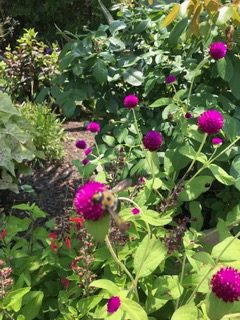Gomphrena globosa or globe amaranth, is a great annual for summer color. It’s easy to grow, thrives in full sun, and is drought tolerant. When the garden needs some color in late summer and early fall, gomphrena is still going strong. It is an old-fashioned cottage garden plant, and is considered an annual in Zone 8. In the hot days of September and October, gomphrena will still be loaded with masses of blooms.
Gomphrena is native to central and South America and has been planted in ornamental gardens for centuries. It was first introduced in Europe in 1714 and then found its way to Virginia in early 1737. John Custis grew it in his Williamsburg Garden. Thomas Jefferson planted the seeds at Shadwell, his boyhood home, and it continues to be grown at Monticello to this day. It is one of the most asked-about flowers in the Monticello gardens. www.Monticello.org
Gomphrena doesn’t require much fertilization. It can easily be propagated by seed or plants from the local garden center. Taller cultivars may need to be staked but this problem can be avoided by pinching back earlier in the season. Deadheading is not necessary, but cutting the flowers will certainly encourage new blooms.
The true flowers are insignificant, tiny white to yellow trumpets. It is the brightly colored bracts arranged in globose, papery textured, clover-like flower heads that attract attention. www.plants.ces.NCSU.edu
Although not native to North America, gomphrena is not aggressive or invasive. If it self-seeds, the seedlings can easily be pulled during the season. It complements other annuals, particularly those with contrasting colors. Gomphrena is impressive in a mass planting of one color or in a couple of shades of the same color. www.piedmontmastergardeners.org
If you are not familiar with gomphrena, be sure to look for it next season. You will be glad that you chose to add it to your garden.
Photos and information by Jeanne Pavero, North Carolina Extension Gardener Plant Toolbox



